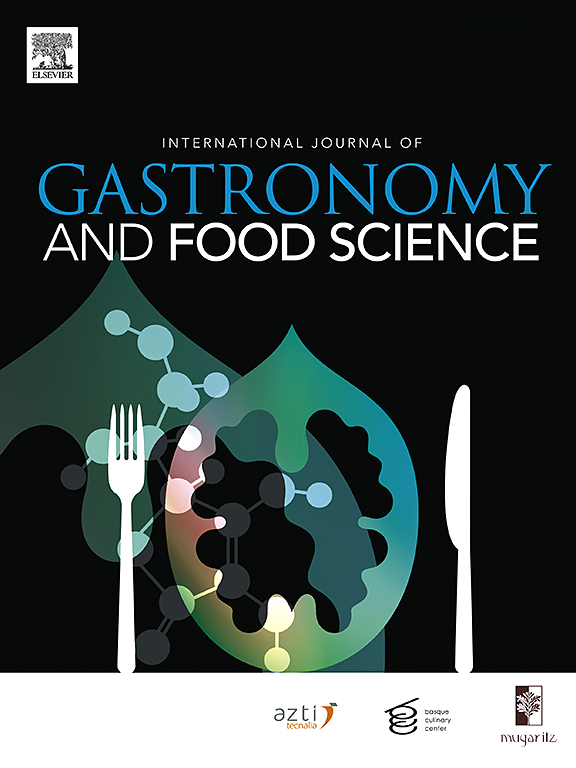不同包装和焯水处理过发酵丹贝(tempe bosok)挥发性成分及香气描述
IF 3.2
2区 农林科学
Q2 FOOD SCIENCE & TECHNOLOGY
International Journal of Gastronomy and Food Science
Pub Date : 2025-01-04
DOI:10.1016/j.ijgfs.2025.101105
引用次数: 0
摘要
在传统的爪哇烹饪中,过度发酵的丹贝独特而独特的香气被用作调味料。使用不同的发酵时间和包装方法,但目前还没有关于发酵时间的长短,仍然可以提供一个令人愉快的香气,这对消费者很重要。为了解决这个问题,进行了一项研究,在发酵过程中进行,直到幼虫出现,然后在干燥teme之前焯水以停止发酵过程。本研究的目的是表征和比较发酵1、4、7和10天的焯水和未焯水的teme样品的主要挥发性化合物和香气属性。过发酵后的主要挥发性化合物包括乙醛(气味活性值[OAV] = 13,311)、壬醛(OAV = 134,826)、1-辛烯-3-醇(OAV = 45,482)、丁酸(OAV = 45,135)、2-壬酮(OAV = 17,058)、苯酚(OAV = 20,149)、3-乙基-2,5-二甲基吡嗪(OAV = 15,433)、2,3-二甲基吡啶(OAV = 19,879)和吲哚(OAV = 22164)。发酵4天以上的样品具有更多样化的香气属性,包括烤、木、鲜味、酸、牛肉、海鲜、霉味、辛辣、咸、腐臭、刺鼻、焦糖和花香。研究发现,焯水可以降低产生异味的挥发性化合物的浓度,比如酸和吲哚。此外,小组成员认为,用塑料包装的焯水的tempe表现出与公众感知一致的香气(独特和独特),增强了菜肴的整体风味。本研究结果将有助于控制过度发酵的豆豉作为食品调味品时的香气质量。本文章由计算机程序翻译,如有差异,请以英文原文为准。
Volatile compounds and aroma descriptions in overfermented tempe (tempe bosok) with different packaging and blanching treatment
The unique and specific aroma of overfermented tempe has been used as a seasoning in traditional Javanese cooking. Different fermentation times and packaging methods are used, but there is currently no information regarding the length of tempe fermentation time that can still provide a pleasant aroma, which is important for consumers. To address this, a study was conducted in which fermentation was carried out until larvae appeared, followed by blanching to stop the fermentation process before drying the tempe. This study aimed to characterize and compare the key volatile compounds and aroma attributes in blanched and nonblanched tempe samples fermented for 1, 4, 7, and 10 days. The key volatile compounds in the overfermented tempe included acetaldehyde (odor activity value [OAV] = 13,311), nonanal (OAV = 134,826), 1-octen-3-ol (OAV = 45,482), butyric acid (OAV = 45,135), 2-nonanone (OAV = 17,058), phenol (OAV = 20,149), 3-ethyl-2,5-dimethylpyrazine (OAV = 15,433), 2,3-dimethylpyridine (OAV = 19,879), and indole (OAV = 22,164). Samples fermented for more than 4 days had more diverse aroma attributes, including toasted, woody, umami, sour, beefy, seafood, musty, spicy, salty, rancid, pungent, caramelic, and floral. Blanching was found to reduce the concentration of volatile compounds responsible for the off flavors, such as acids and indole. In addition, the panelists perceived that the blanched tempe with plastic wrapping exhibited an aroma consistent with the public's perception (distinctive and unique), enhancing the overall flavor of the dish. The findings of this study will help control aroma quality from overfermented tempe when used as a food seasoning.
求助全文
通过发布文献求助,成功后即可免费获取论文全文。
去求助
来源期刊

International Journal of Gastronomy and Food Science
Social Sciences-Cultural Studies
CiteScore
5.30
自引率
10.50%
发文量
170
审稿时长
45 days
期刊介绍:
International Journal of Gastronomy and Food Science is a peer-reviewed journal that explicitly focuses on the interface of food science and gastronomy. Articles focusing only on food science will not be considered. This journal equally encourages both scientists and chefs to publish original scientific papers, review articles and original culinary works. We seek articles with clear evidence of this interaction. From a scientific perspective, this publication aims to become the home for research from the whole community of food science and gastronomy.
IJGFS explores all aspects related to the growing field of the interaction of gastronomy and food science, in areas such as food chemistry, food technology and culinary techniques, food microbiology, genetics, sensory science, neuroscience, psychology, culinary concepts, culinary trends, and gastronomic experience (all the elements that contribute to the appreciation and enjoyment of the meal. Also relevant is research on science-based educational programs in gastronomy, anthropology, gastronomic history and food sociology. All these areas of knowledge are crucial to gastronomy, as they contribute to a better understanding of this broad term and its practical implications for science and society.
 求助内容:
求助内容: 应助结果提醒方式:
应助结果提醒方式:


